
| home | catalogue | history | references | appendix |
 |
surfresearch.com.au
the
catalogue #101
|
| 1949 Kelvin-Quigg Malibu (also incorrectly catalogued as Simmons' Spoon) 9ft 10" |
#101
|

|
Length:
|
9
|
feet |
9 3/4
|
inches | ||
|
Width:
|
24"
|
inches |
Wide
Point:
|
+ | inches | |
|
Nose
:
|
inches |
Tail:
|
inches | |||
|
Thickness:
|
3
|
inches |
Pod:
|
13
|
inches | |
|
Nose/L:
|
inches |
Tail/L:
|
inches | |||
|
Weight
|
16.3
|
kilograms |
Volume
|
litres | ||
|
Other
|
| FIN
Rounded keel, Glassed timber, 5 1/2" x 10" base Image right,''1949 -Simmons Radius Fin 3 1/2'' deep x 13 1/2'' long Koa Wood" from SurferMagazine Volume 17 No 2 July 1976 The Malibu Fin Appendix, page 69 |
 |
Exhibited : Surf!
Enviroment
Politics and Life 1960 - 1985.
Laperouse
Museum,
The Cable Station, Botany Bay National Park, Sydney.
12 December
1997
- 13 June 1998.
Curator :
Stephen
Thompson/NSW National Parks and Wildlife Service
Photographs by
Bob
Gumley.

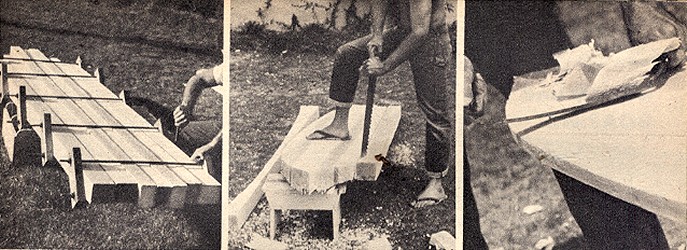
| Matt uses Weldwood glue
and long clamps to fasten the planks. |
Design is drawn on the
surface and is rough-hewn with saw. |
Following design drawn
on sides, surface is shaped with drawblade. |
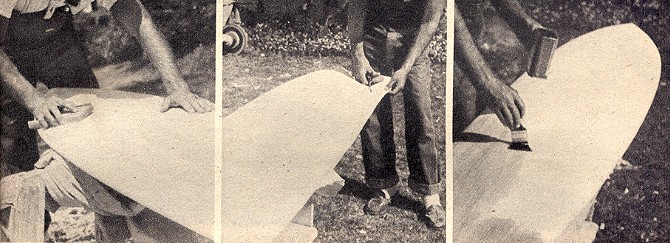
| Entire surface is now
shaped with rough sand paper, then fine. |
Plastic resin is applied.
Fiberglas is set into it and trimmed. |
Now fill the cloth with
several coats of resin, sanding between. |
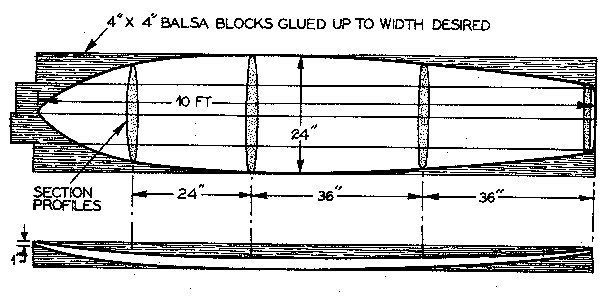
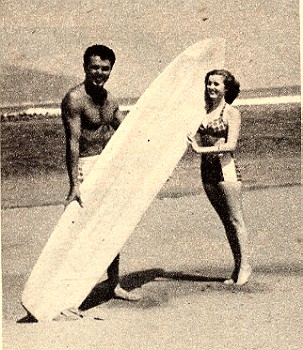
of the surfboard with Miss Jean Moorehead. |
easy to make and thrilling to ride. By Edna Wood Standard length is about ten feet. If you weigh around 125 lbs., 3 in. of thickness is about right, 3 1/2 in. if you're 140 to 180 lbs., etc. Glued balsa timbers are left clamped together overnight, then lines are drawn, board is rough-hewn, shaped, smoothed, rough-sanded, coated with plastic resin which glues on Fiberglas. Top coat of resin is applied and allowed to harden dry before sanding. A coat of thick-gloss paint gives the board a perfect finish. |
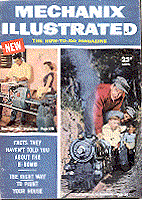 |
September 1954 Volume 50 Number 9 Surfboards Edna Wood/Matt Kivlin pages 72 - 73 |
As noted the blank is made up of laminated short balsa lengths, recycled from WW11 lifeboats where it was used as buoyancy. The quality of the finish of the board suggests that it has a least been re-glossed and polished, if not completely reglassed. It is unlikely that this finish was technically feasible in 1950 let alone maintain it. If the board has been re-glassed then the original shape may have been modified.
Lack of markings and/or decal is standard. Attribution ‘made in Hawaii’ is open to question, the majority of these boards where probably manufactured and used on the US mainland. See Notes on Fiberglass.
This design was probably not used in Australia, but Australian surfers were aware of the design as early as 1953 on visits to Hawaii. It was the precursor to the Malibu board, introduced by the visiting US / Hawaii teams to the 1956 International Surf Carnival Torquay Vic., held in conjunction with the Melbourne Olympic Games. Team members subsequently visited Sydney. Historically this is a remarkably significant item.
The construction pioneered by Bob Simmons of a hand shaped blank covered in fibreglass and resin and an attached fin is still the current preferred manufacturing method of surfboards today (1999). As Duke Kahanamoku is considered ‘the father of modern surfing’, Bob Simmons is considered by many as ‘the father of the modern surfboard’.

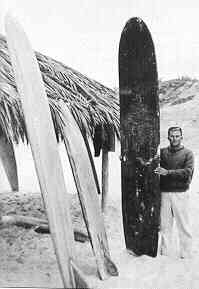 |
John
Ewell
with a Bob Simmons' early model timber/styro-foam
laminate board, circa
1947.
The two boards in the foreground are later glassed balsa boards, similar to # 101. The shorter board (sub 8 ft?) is particually interesting. In the left background, the tail of a hollow board shows leaning on the other side of the hut. Photograph: Uncredited, circa 1951. Probably John Ewell Collection Reprinted in Surfing Vol 25 No. 2 February 1989, page 71 . John Ewell was said to be preparing a biography of Bob Simmons. |

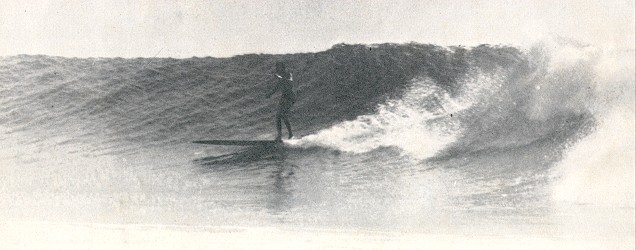
It is certainly made of pieces of balsa with the assumption it is made from an old balsa Navy life raft.
If it was a Simmons' spoon there would be a perfect semi circle on the bottom from the wedge. On top it would a straight glue joint.
What happened during this time was that the Malibu board became a modified Simmons' with no wedge and a pointed nose. I have seen one board that had a pointed nose that had a wedge. A lot of people tried wedges, but never got it right. Simmons did not like pointed noses.
This board does not have the strict parallellism that all Simmons have. Near the tail they of course pulled in somewhat.
I don't think Simmons would even bother to shape such a board because of all the glue joints that dull tools and catch when it is shaped. My guess it is a Quigg board or Kivlin. They started to fare in the tails a little more later. The first modified copies of Simmons' were identical in shape except there was no wedge and pointed. Velzy said they did this because it was too hard to jig the nose and make the wedge. Morgan said they did want to appear they had copied a Simmons.
I still have a 9 foot Simmons that I rode in 1950 with dual fins in mint condition. The clue to an authenic Simmons spoon are the circular glue joint behing the nose and a straight glue joint behind the nose from the wedge. The nose on top is dished out.
Someone should straighten this out. There are plenty of misrepresented surfboards for sale.
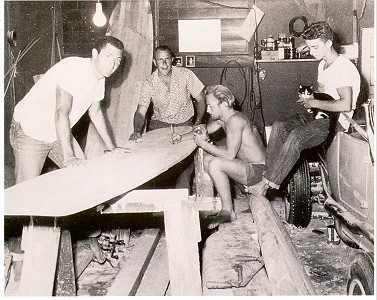 |
Image right,
Dale Velzy 's Shaping Bay, circa 1947 Dale Velzy /C.R. Stecyk Collection Note the upright multi-laminated balsa blank, left. Image printed in
|

| home | catalogue | history | references | appendix |